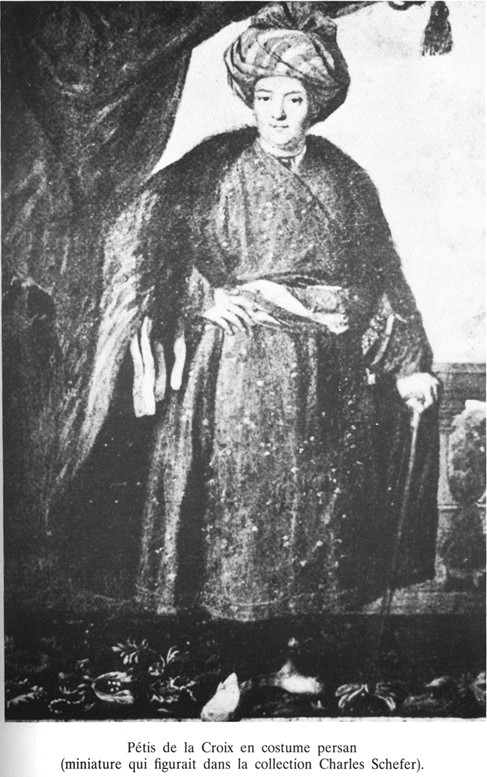FRANCOIS PÉTIS DE LA CROIX
Francois Pétis de la Croix (1653-1713) was a French orientalist and interpreter at the French court. He was born in Paris and travelled to Aleppo within a programme initiated by the Minister of Trade Colbert to train young translators in the Oriental languages. These students, named jeunes de langue stayed in the Levant for several years in order to learn Turkish, Persian and Arabic to work as translators and interpreters and foster French trade and diplomatic communication. From 1674-1676 he stayed in the Persian town Isfahan. After this period he was employed as a secretary, translator and interpreter in Morocco, Algiers, Tunis and Tripoli. In 1692 he obtained the chair of Arabic in the Collège Royal and in 1695 he was appointed royal interpreter for Arabic, Turkish and Persian. He was an esteemed colleague and friend of Antoine Galland. Pétis de la Croix is mainly remembered for his translation of Persian and Turkish tales following the example of Galland’s Mille et une nuit. In 1707 he published Contes turcs and Les mille et un jours (5 volumes; 1710-1712). Like the Thousand and one nights, these collections became popular and were translated in the main European languages. When the first volumes of the Mille et une nuit had been published, while Galland were still working on his translation, Pétis de la Croix sent some stories to the editor, who included them in the 8th volume of Galland’s translation, without informing Galland. This led to a temporary estrangement between the two orientalists, but Pétis de la Croix succeeded in convincing Galland that he had not been informed either. These stories are ‘The tale of Zeyn al-Asnam’, ‘Khudadad and his brothers’, and the ‘History of Princess Daryabar’. The text of these stories, and the stories in Les mille et un jours, were probably edited by the French author Alain René Lesage. Pétis de la Croix’s other publications include translations of the travels of Sindbad (Les voyages de Sindbad), Kalila wa-Dimna (a Persian mirror-for-princes), and The story of the forty viziers (1707). A translation of Sharaf al-Din Ali’s Zafarnama (a history of Timur Lang/ Tamerlane) was published in four volumes after his death in 1722 (translated into English in 1723). He also edited a history of Genghis Khan written by his father, who was also a well-known orientalist.
The fragments:
The collection Les mille et un jours is presented as a genuine translation of a Persian text by a certain Dervish Moclès (Mukhlis), supposedly Pétis’ teacher while he was in Isfahan. Although a meeting with a certain Moclès is testified in Pétis’ journals, the attribution of the text to him is certainly a mystification. This was discovered by the Austrian orientalist Josef von Hammer-Purgstall at the end of the 18th century. The material for the collection is drawn from various sources, but especially from a Turkish collection of tales titled ‘Al-Faraj ba’d al-Shidda’, a spurious collection of tales popular at the time. The collection is structured as a framestory: in the framing story it is explained how stories are told by Sutlumemé to Princess Farrukhnaz to cure her of her aversion from men and to convince her that true love can exist. The embedded stories are similar to Thousand and one nights stories. Although some of them are reworked or composite versions of well-known tales. The tales selected here are, first, the framing story and the first stories, the story of ‘Aboulcassem’, and ‘Ruzvanschad’; second, the cycle of ‘Aboulfaouaris’, which is often compared to the ‘Sindbad’ cycle; and, third, ‘Histoire du prince Calaf et de la princesse de la Chine’, which became the source for several adaptations and the opera Turandot by Puccini (1924). Immediately after its appearance, the Mille et un jours were considered part of the genuine corpus of Oriental tales and as such it was highly influential in shaping the genre during the course of the 18th century. Several stories were adapted for the stage, in the form of ‘Arlequinades’. Some readers liked the tales better than their more ‘authentic’ counterpart, the Mille et une nuit.

Sources/references:
Les mille et un jours; contes persans, ed. Christelle Bahier-Porte/ Pierre Brunel, Honoré Champion, Paris 2011.
Paul Sebag, ‘Sur deux orientalistes francais du XVIIe siècle: F. Pétis de la Croix et le sieur de la Croix,’ Revue de l’occident musulman et de la Méditerranée, vol. 25, no 1 (1998), pp. 89-117. (http://www.persee.fr/web/revues/home/prescript/article/remmm_0035-1474_1978_num_25_1_1805)
Ulrich Marzolph/ Richard van Leeuwen, The Arabian nights encyclopedia, 2 vols., ABC-Clio, Santa Barbara etc. 2004.
Histoire du prince Calaf et de la princesse de la Chine, ed. Paul Sebag, L’Harmattan, Paris 2000.